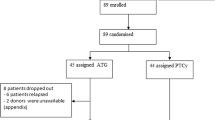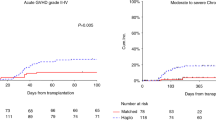Abstract
Severe regimen-related toxicity often complicates second transplant procedures performed in patients with hematological malignancies that have relapsed after an initial hematopoietic stem cell (HSC) transplant. Therefore, we studied the safety and efficacy of a reduced-intensity fludarabine and melphalan based conditioning regimen in 11 patients who had relapsed following an autologous (n = 7) or allogeneic (n = 4) HSC transplant. All patients received allogeneic peripheral blood HSC from either an HLA-identical (n = 7) or an HLA-mismatched (n = 4) relative. Diagnoses included AML (n = 9), ALL (n = 1), or Hodgkin's disease (n = 1). Only one patient was in complete remission at the time of second transplant. The median interval between first transplant and relapse was 163 days (range 58–1885). Recipients of HLA-mismatched transplants received antithymocyte globulin in addition to fludarabine and melphalan as part of the conditioning regimen. All 11 patients received acute GVHD prophylaxis consisting of tacrolimus and methotrexate. Ten of 11 patients achieved hematopoietic engraftment with a median time to absolute neutrophil count >0.5 × 109/l and to platelet count of >20 × 109/l of 14 and 19 days, respectively. All engrafting patients achieved 100% donor chimerism on initial analysis, except for one with persistent leukemia at day +19. Two patients experienced grade 3 regimen-related toxicity, manifesting as acute renal failure. Acute GVHD grades 2–4 occurred in two recipients and chronic GVHD in four. The 100-day mortality from all causes was 36%. Ten of 11 patients (91%) died a median of 140 days (range 9–996) after the second transplant. The causes of death included relapse (n = 5), sepsis (n = 4), and idiopathic pneumonia syndrome (n = 1). One patient with AML survives in remission at 880 days post-transplant. We conclude that fludarabine- and melphalan-based conditioning promotes full donor chimerism, even following HLA-mismatched transplants. However, the regimen may be more beneficial when applied to patients undergoing allogeneic HSC transplantation earlier in their disease course. Bone Marrow Transplantation (2001) 28, 557–562.
This is a preview of subscription content, access via your institution
Access options
Subscribe to this journal
Receive 12 print issues and online access
$259.00 per year
only $21.58 per issue
Buy this article
- Purchase on Springer Link
- Instant access to full article PDF
Prices may be subject to local taxes which are calculated during checkout

Similar content being viewed by others
References
Giralt SA, Champlin RE . Leukemia relapse after allogeneic bone marrow transplantation: a review Blood 1994 84: 3603–3612
Kumar L . Leukemia: management of relapse after allogeneic bone marrow transplantation J Clin Oncol 1994 12: 1710–1717
Collins RH Jr, Shpilberg O, Drobyski WR et al. Donor leukocyte infusions in 140 patients with relapsed malignancy after allogeneic bone marrow transplantation J Clin Oncol 1997 15: 433–444
Kolb HJ, Schattenberg A, Goldman JM et al. Graft-versus-leukemia effect of donor lymphocyte transfusions in marrow grafted patients. European Group for Blood and Marrow Transplantation Working Party Chronic Leukemia Blood 1995 86: 2041–2050
Barrett AJ, Locatelli F, Treleaven JG et al. Second transplants for leukaemic relapse after bone marrow transplantation: high early mortality but favourable effect of chronic GVHD on continued remission. A report by the EBMT Leukaemia Working Party Br J Haematol 1991 79: 567–574
Chiang KY, Weisdorf DJ, Davies SM et al. Outcome of second bone marrow transplantation following a uniform conditioning regimen as therapy for malignant relapse Bone Marrow Transplant 1996 17: 39–42
Frassoni F, Barrett AJ, Granena A et al. Relapse after allogeneic bone marrow transplantation for acute leukaemia: a survey by the EBMT of 117 cases Br J Haematol 1988 70: 317–320
Kishi K, Takahashi S, Gondo H et al. Second allogeneic bone marrow transplantation for post-transplant leukemia relapse: results of a survey of 66 cases in 24 Japanese institutes Bone Marrow Transplant 1997 19: 461–466
Mehta J, Powles R, Treleaven J et al. Outcome of acute leukemia relapsing after bone marrow transplantation: utility of second transplants and adoptive immunotherapy Bone Marrow Transplant 1997 19: 709–719
Michallet M, Tanguy ML, Socie G et al. Second allogeneic haematopoietic stem cell transplantation in relapsed acute and chronic leukaemias for patients who underwent a first allogeneic bone marrow transplantation: a survey of the Société Française de Greffe de Moelle (SFGM) Br J Haematol 2000 108: 400–407
Mrsic M, Horowitz MM, Atkinson K et al. Second HLA-identical sibling transplants for leukemia recurrence Bone Marrow Transplant 1992 9: 269–275
Radich JP, Sanders JE, Buckner CD et al. Second allogeneic marrow transplantation for patients with recurrent leukemia after initial transplant with total-body irradiation-containing regimens J Clin Oncol 1993 11: 304–313
Radich JP, Gooley T, Sanders JE et al. Second allogeneic transplantation after failure of first autologous transplantation Biol Blood Marrow Transplant 2000 6: 272–279
Tsai T, Goodman S, Saez R et al. Allogeneic bone marrow transplantation in patients who relapse after autologous transplantation Bone Marrow Transplant 1997 20: 859–863
Mortimer J, Blinder MA, Schulman S et al. Relapse of acute leukemia after marrow transplantation: natural history and results of subsequent therapy J Clin Oncol 1989 7: 50–57
Giralt S, Estey E, Albitar M et al. Engraftment of allogeneic hematopoietic progenitor cells with purine analog-containing chemotherapy: harnessing graft-versus-leukemia without myeloablative therapy Blood 1997 89: 4531–4536
Giralt S, Thall PF, Khouri I et al. Melphalan and purine analog-containing preparative regimens: reduced-intensity conditioning for patients with hematologic malignancies undergoing allogeneic progenitor cell transplantation Blood 2001 97: 631–637
Winston DJ, Ho WG, Bartoni K et al. Ganciclovir prophylaxis of cytomegalovirus infection and disease in allogeneic bone marrow transplant recipients. Results of a placebo-controlled, double-blind trial Ann Intern Med 1993 118: 179–184
Einsele H, Ehninger G, Hebart H et al. Polymerase chain reaction monitoring reduces the incidence of cytomegalovirus disease and the duration and side effects of antiviral therapy after bone marrow transplantation Blood 1995 86: 2815–2820
Kawano Y, Takaue Y, Watanabe A et al. Partially mismatched pediatric transplants with allogeneic CD34(+) blood cells from a related donor Blood 1998 92: 3123–3130
Stainer CJ, Miflin G, Anderson S et al. A comparison of two different systems for CD34+ selection of autologous or allogeneic PBSC collections J Hematother 1998 7: 375–383
Przepiorka D, Weisdorf D, Martin P et al. 1994 Consensus conference on acute GVHD grading Bone Marrow Transplant 1995 15: 825–828
Sullivan KM, Agura E, Anasetti C et al. Chronic graft-versus-host disease and other late complications of bone marrow transplantation Semin Hematol 1991 28: 250–259
Bearman SI, Appelbaum FR, Buckner CD et al. Regimen-related toxicity in patients undergoing bone marrow transplantation J Clin Oncol 1988 6: 1562–1568
Horwitz ME, Barrett AJ, Brown MR et al. Treatment of chronic granulomatous disease with nonmyeloablative conditioning and a T cell-depleted hematopoietic allograft New Engl J Med 2001 344: 881–888
Kaplan EL, Meier P . Nonparametric estimation from incomplete observations J Am Stat Assoc 1958 53: 457–481
Gharpure VS, Devine SM, Holland HK et al. Thrombotic thrombocytopenic purpura associated with FK506 following bone marrow transplantation Bone Marrow Transplant 1995 16: 715–716
Bensinger WI, Martin PJ, Storer B et al. Transplantation of bone marrow as compared with peripheral-blood cells from HLA-identical relatives in patients with hematologic cancers New Engl J Med 2001 344: 175–181
Champlin RE, Schmitz N, Horowitz MM et al. Blood stem cells compared with bone marrow as a source of hematopoietic cells for allogeneic transplantation. IBMTR Histocompatibility and Stem Cell Sources Working Committee and the European Group for Blood and Marrow Transplantation (EBMT) Blood 2000 95: 3702–3709
Ratanatharathorn V, Nash RA, Przepiorka D et al. Phase III study comparing methotrexate and tacrolimus with methotrexate and cyclosporine for graft-versus-host disease prophylaxis after HLA-identical sibling bone marrow transplantation Blood 1998 92: 2303–2314
de Lima M, van Besien K, Gajewski J et al. High-dose melphalan and allogeneic peripheral blood stem cell transplantation for treatment of early relapse after allogeneic transplant Bone Marrow Transplant 2000 26: 333–338
Bacigalupo A, Vitale V, Corvo R et al. The combined effect of total body irradiation (TBI) and cyclosporin A (CyA) on the risk of relapse in patients with acute myeloid leukaemia undergoing allogeneic bone marrow transplantation Br J Haematol 2000 108: 99–104
Storb R, Leisenring W, Anasetti C et al. Methotrexate and cyclosporine for graft-vs-host disease prevention: what length of therapy with cyclosporine? Biol Blood Marrow Transplant 1997 3: 194–201
Falkenburg JH, Wafelman AR, Joosten P et al. Complete remission of accelerated phase chronic myeloid leukemia by treatment with leukemia-reactive cytotoxic T lymphocytes Blood 1999 94: 1201–1208
Ruggeri L, Capanni M, Casucci M et al. Role of natural killer cell alloreactivity in HLA-mismatched hematopoietic stem cell transplantation Blood 1999 94: 333–339
Tiberghien P, Ferrand C, Lioure B et al. Administration of herpes simplex-thymidine kinase-expressing donor T cells with a T cell-depleted allogeneic marrow graft Blood 2001 97: 63–72
Author information
Authors and Affiliations
Rights and permissions
About this article
Cite this article
Devine, S., Sanborn, R., Jessop, E. et al. Fludarabine and melphalan-based conditioning for patients with advanced hematological malignancies relapsing after a previous hematopoietic stem cell transplant. Bone Marrow Transplant 28, 557–562 (2001). https://doi.org/10.1038/sj.bmt.1703198
Received:
Accepted:
Published:
Issue Date:
DOI: https://doi.org/10.1038/sj.bmt.1703198
Keywords
This article is cited by
-
CD34+ cell dose and establishment of full donor chimerism at day +100 are important factors for survival with reduced-intensity conditioning with fludarabine and melphalan before allogeneic hematopoietic SCT for hematologic malignancies
Bone Marrow Transplantation (2010)
-
Chemotherapy-associated renal dysfunction
Nature Reviews Nephrology (2009)
-
Feasibility of a dose-adjusted fludarabine–melphalan conditioning prior autologous stem cell transplantation in a dialysis-dependent patient with mantle cell lymphoma
Annals of Hematology (2009)
-
Treatment options for the management of acute leukaemia relapsing following an allogeneic transplant
Bone Marrow Transplantation (2008)
-
Fludarabine phosphate and melphalan: a reduced intensity conditioning regimen suitable for allogeneic transplantation that maintains the graft versus malignancy effect
Bone Marrow Transplantation (2006)



